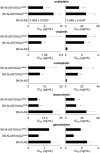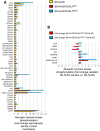Acquired resistance to oxaliplatin is not directly associated with increased resistance to DNA damage in SK-N-ASrOXALI4000, a newly established oxaliplatin-resistant sub-line of the neuroblastoma cell line SK-N-AS
- PMID: 28192521
- PMCID: PMC5305101
- DOI: 10.1371/journal.pone.0172140
Acquired resistance to oxaliplatin is not directly associated with increased resistance to DNA damage in SK-N-ASrOXALI4000, a newly established oxaliplatin-resistant sub-line of the neuroblastoma cell line SK-N-AS
Abstract
The formation of acquired drug resistance is a major reason for the failure of anti-cancer therapies after initial response. Here, we introduce a novel model of acquired oxaliplatin resistance, a sub-line of the non-MYCN-amplified neuroblastoma cell line SK-N-AS that was adapted to growth in the presence of 4000 ng/mL oxaliplatin (SK-N-ASrOXALI4000). SK-N-ASrOXALI4000 cells displayed enhanced chromosomal aberrations compared to SK-N-AS, as indicated by 24-chromosome fluorescence in situ hybridisation. Moreover, SK-N-ASrOXALI4000 cells were resistant not only to oxaliplatin but also to the two other commonly used anti-cancer platinum agents cisplatin and carboplatin. SK-N-ASrOXALI4000 cells exhibited a stable resistance phenotype that was not affected by culturing the cells for 10 weeks in the absence of oxaliplatin. Interestingly, SK-N-ASrOXALI4000 cells showed no cross resistance to gemcitabine and increased sensitivity to doxorubicin and UVC radiation, alternative treatments that like platinum drugs target DNA integrity. Notably, UVC-induced DNA damage is thought to be predominantly repaired by nucleotide excision repair and nucleotide excision repair has been described as the main oxaliplatin-induced DNA damage repair system. SK-N-ASrOXALI4000 cells were also more sensitive to lysis by influenza A virus, a candidate for oncolytic therapy, than SK-N-AS cells. In conclusion, we introduce a novel oxaliplatin resistance model. The oxaliplatin resistance mechanisms in SK-N-ASrOXALI4000 cells appear to be complex and not to directly depend on enhanced DNA repair capacity. Models of oxaliplatin resistance are of particular relevance since research on platinum drugs has so far predominantly focused on cisplatin and carboplatin.
Conflict of interest statement
The authors have declared that no competing interests exist.
Figures






Similar articles
-
Molecular Dissection of Induced Platinum Resistance through Functional and Gene Expression Analysis in a Cell Culture Model of Bladder Cancer.PLoS One. 2016 Jan 22;11(1):e0146256. doi: 10.1371/journal.pone.0146256. eCollection 2016. PLoS One. 2016. PMID: 26799320 Free PMC article.
-
Genome-wide identification of genes conferring resistance to the anticancer agents cisplatin, oxaliplatin, and mitomycin C.Cancer Res. 2004 Jun 1;64(11):3940-8. doi: 10.1158/0008-5472.CAN-03-3113. Cancer Res. 2004. PMID: 15173006
-
Role of the DNA base excision repair protein, APE1 in cisplatin, oxaliplatin, or carboplatin induced sensory neuropathy.PLoS One. 2014 Sep 4;9(9):e106485. doi: 10.1371/journal.pone.0106485. eCollection 2014. PLoS One. 2014. PMID: 25188410 Free PMC article.
-
Oxaliplatin: mechanism of action and antineoplastic activity.Semin Oncol. 1998 Apr;25(2 Suppl 5):4-12. Semin Oncol. 1998. PMID: 9609103 Review.
-
Cellular and molecular pharmacology of oxaliplatin.Mol Cancer Ther. 2002 Jan;1(3):227-35. Mol Cancer Ther. 2002. PMID: 12467217 Review.
Cited by
-
Genome-wide single-nucleotide resolution of oxaliplatin-DNA adduct repair in drug-sensitive and -resistant colorectal cancer cell lines.J Biol Chem. 2020 May 29;295(22):7584-7594. doi: 10.1074/jbc.RA120.013347. Epub 2020 Apr 16. J Biol Chem. 2020. PMID: 32299912 Free PMC article.
-
Towards image-based cancer cell lines authentication using deep neural networks.Sci Rep. 2020 Nov 16;10(1):19857. doi: 10.1038/s41598-020-76670-6. Sci Rep. 2020. PMID: 33199764 Free PMC article.
-
Preclinical Models of Neuroblastoma-Current Status and Perspectives.Cancers (Basel). 2023 Jun 23;15(13):3314. doi: 10.3390/cancers15133314. Cancers (Basel). 2023. PMID: 37444423 Free PMC article. Review.
-
SAP30, an oncogenic driver of progression, poor survival, and drug resistance in neuroblastoma.Mol Ther Nucleic Acids. 2022 Mar 21;35(2):101543. doi: 10.1016/j.omtn.2022.03.014. eCollection 2024 Jun 11. Mol Ther Nucleic Acids. 2022. PMID: 38817681 Free PMC article.
-
Inhibition of mitotic kinase Mps1 promotes cell death in neuroblastoma.Sci Rep. 2020 Jul 20;10(1):11997. doi: 10.1038/s41598-020-68829-y. Sci Rep. 2020. PMID: 32686724 Free PMC article.
References
-
- Schroeder A, Heller DA, Winslow MM, Dahlman JE, Pratt GW, Langer R, et al. Treating metastatic cancer with nanotechnology. Nat Rev Cancer. 2012;12: 39–50. - PubMed
-
- Domingo-Domenech J, Vidal SJ, Rodriguez-Bravo V, Castillo-Martin M, Quinn SA, Rodriguez-Barrueco R, et al. Suppression of acquired docetaxel resistance in prostate cancer through depletion of notch- and hedgehog-dependent tumor-initiating cells. Cancer Cell 2012;22: 373–388. 10.1016/j.ccr.2012.07.016 - DOI - PMC - PubMed
MeSH terms
Substances
Grants and funding
- BB/E010652/1/BB_/Biotechnology and Biological Sciences Research Council/United Kingdom
- BB/E024211/1/BB_/Biotechnology and Biological Sciences Research Council/United Kingdom
- G19438/2/BB_/Biotechnology and Biological Sciences Research Council/United Kingdom
- MR/L00870X/1/MRC_/Medical Research Council/United Kingdom
LinkOut - more resources
Full Text Sources
Other Literature Sources
Research Materials

